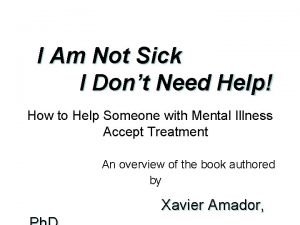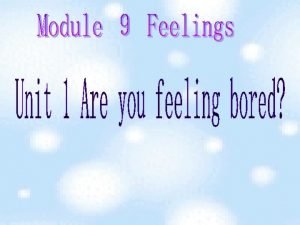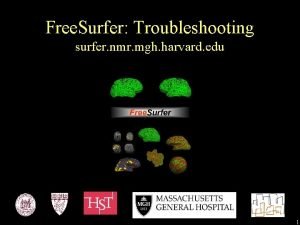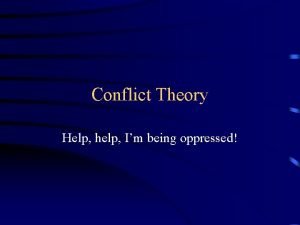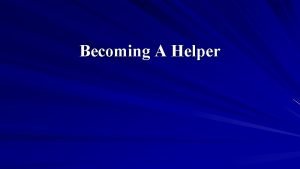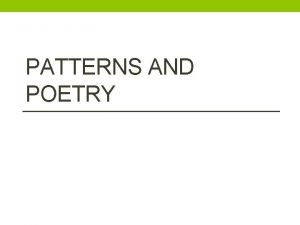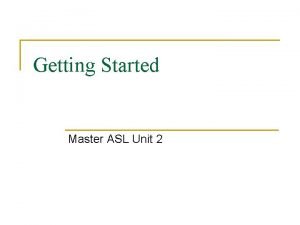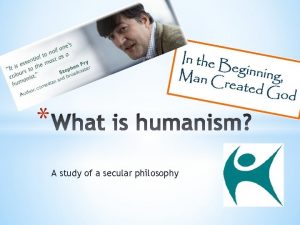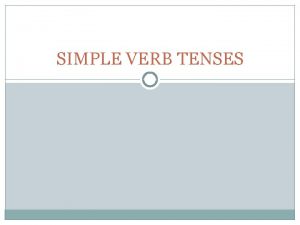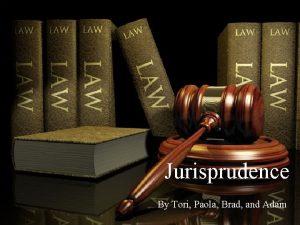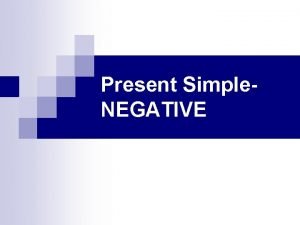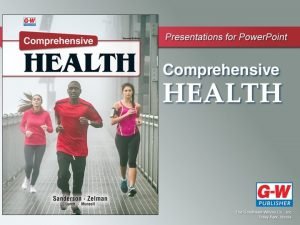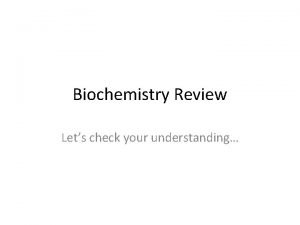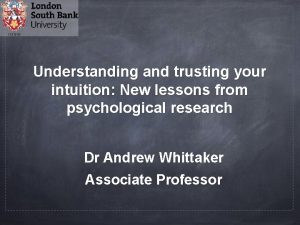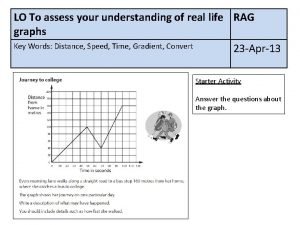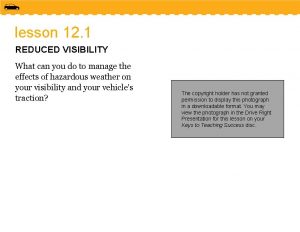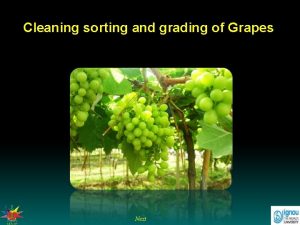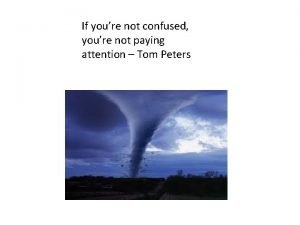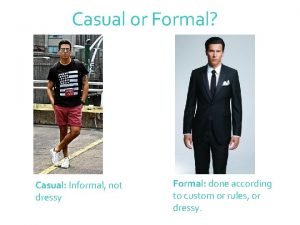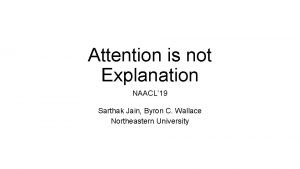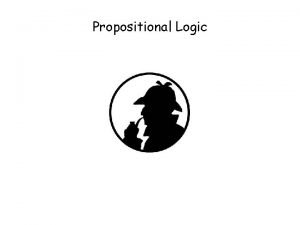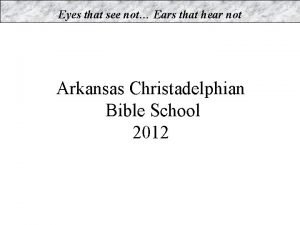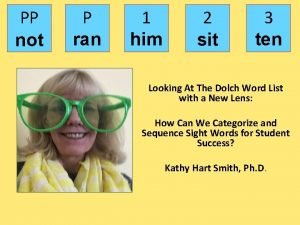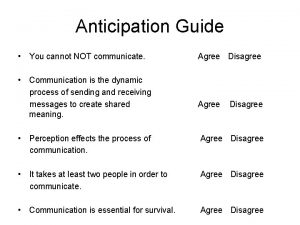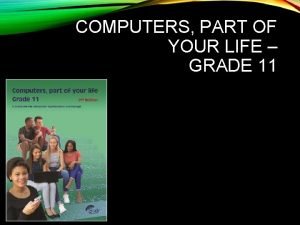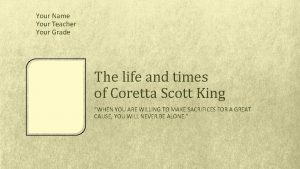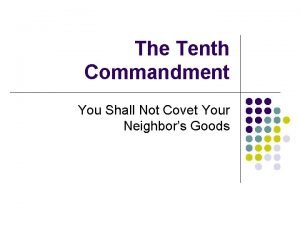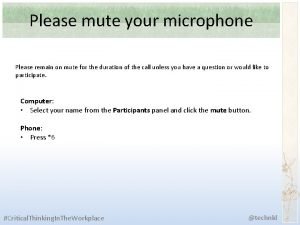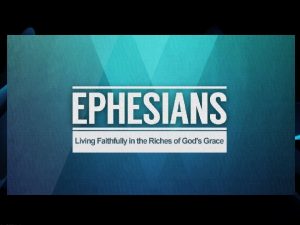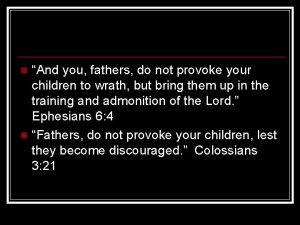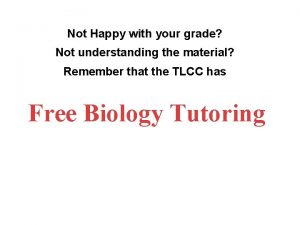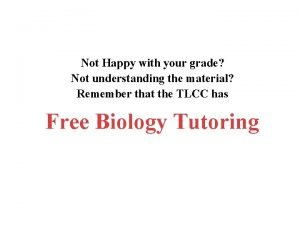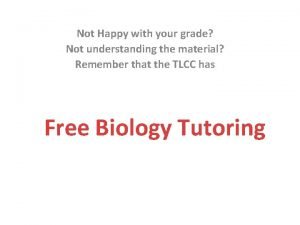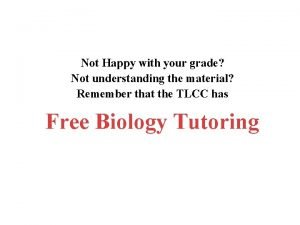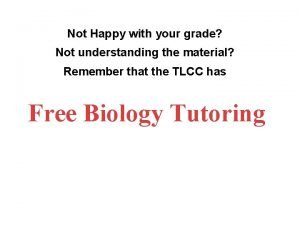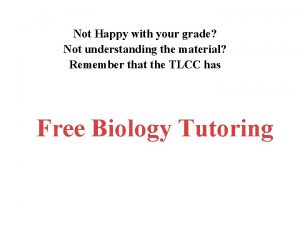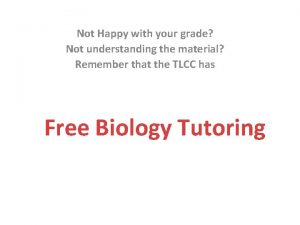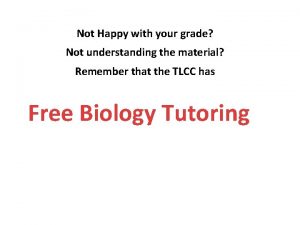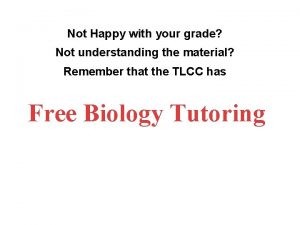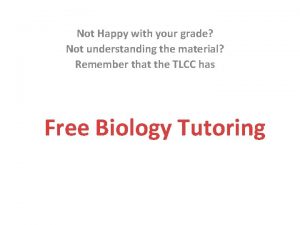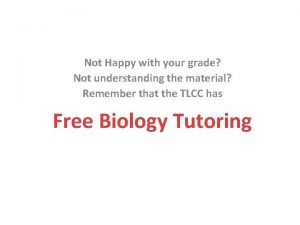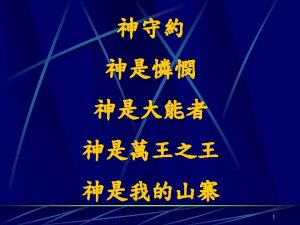Not happy with your grade Need help understanding












































































- Slides: 76

Not happy with your grade? Need help understanding the material? The TLCC Has Free Tutoring Copyright © 2008 Pearson Education Inc. , publishing as Pearson Benjamin Cummings

Chapter 23 The Evolution of Populations (“of populations” = stupid title) Power. Point® Lecture Presentations for Biology Eighth Edition Neil Campbell and Jane Reece Lectures by Chris Romero, updated by Erin Barley with contributions from Joan Sharp Copyright © 2008 Pearson Education, Inc. , publishing as Pearson Benjamin Cummings

Overview: The Smallest Unit of Evolution • Natural selection acts on individuals, but only populations evolve • Genetic variations in populations contribute to evolution • Microevolution is a change in allele frequencies in a population over generations Copyright © 2008 Pearson Education Inc. , publishing as Pearson Benjamin Cummings

Fig. 23 -1

Concept 23. 1: Mutation and sexual reproduction produce the genetic variation that makes evolution possible • mutation and sexual reproduction produce genetic variation • Genetic variation creates phenotypic differences • Natural selection chooses between different phenotypes Copyright © 2008 Pearson Education Inc. , publishing as Pearson Benjamin Cummings

Genetic Variation • Variation in individual genotype is one of causes of phenotype variation • Not all phenotypic variation is heritable • “Natural selection can only act on variation with a genetic component” WRONG • Natural selection can’t make non-genetic stuff be passed on Copyright © 2008 Pearson Education Inc. , publishing as Pearson Benjamin Cummings

Types of Variation Within a Population • Both discrete and quantitative characters contribute to variation within a population • Discrete characters can be classified on an either-or basis • Quantitative characters vary along a continuum within a population Copyright © 2008 Pearson Education Inc. , publishing as Pearson Benjamin Cummings

Variation Between Populations • Most species exhibit geographic variation, differences between gene pools of separate populations or population subgroups Copyright © 2008 Pearson Education Inc. , publishing as Pearson Benjamin Cummings

Fig. 23 -3 1 2. 4 8. 11 9. 12 3. 14 5. 18 10. 16 13. 17 6 7. 15 19 XX 1 2. 19 3. 8 4. 16 5. 14 9. 10 11. 12 13. 17 15. 18 6. 7 XX

• Cline: graded change along a geographic axis Hope Hollocher Drosophilia Copyright © 2008 Pearson Education Inc. , publishing as Pearson Benjamin Cummings

Mutation • Mutations are changes in the nucleotide sequence of DNA • Mutations cause new genes and alleles to arise • Only mutations in cells that produce gametes can be passed to offspring Animation: Genetic Variation from Sexual Recombination Copyright © 2008 Pearson Education Inc. , publishing as Pearson Benjamin Cummings

Point Mutations • A point mutation is a change in one base in a gene The effects of point mutations can vary: Mutations in noncoding regions of DNA are often harmless Mutations in a gene might not affect protein production because of redundancy in the genetic code (silent mutation) Copyright © 2008 Pearson Education Inc. , publishing as Pearson Benjamin Cummings

• The effects of point mutations can vary: – Mutations in noncoding regions of DNA are often harmless – Mutations in a gene that don’t change the amino acid are harmless – mutations that make a stop codon usually screw things up Copyright © 2008 Pearson Education Inc. , publishing as Pearson Benjamin Cummings

– Mutations that change the amino acid MAY be harmless, or may have an effect Copyright © 2008 Pearson Education Inc. , publishing as Pearson Benjamin Cummings

• The effects of point mutations can vary: 1. No effect 2. change that reduces function (harmful) 3. change that improves protein function • Can make organism better at job in environment Natural selection will choose between these alleles if they alter the phenotype Copyright © 2008 Pearson Education Inc. , publishing as Pearson Benjamin Cummings

Mutations That Alter Gene Number or Sequence • Chromosomal mutations that delete, disrupt, or rearrange many loci are typically harmful • Duplication of large chromosome segments is usually harmful (exception: plants) • Duplication of small pieces of DNA is sometimes less harmful and increases the genome size • Duplicated genes can take on new functions by further mutation Copyright © 2008 Pearson Education Inc. , publishing as Pearson Benjamin Cummings

Mutation Rates • Mutation rates are low in animals and plants • The average is about one mutation in every 100, 000 genes per generation • Mutations rates are often lower in prokaryotes and higher in viruses Why? Many have single stranded nucleic acids Copyright © 2008 Pearson Education Inc. , publishing as Pearson Benjamin Cummings

Sexual Reproduction • Sexual reproduction makes new combinations of alleles (2 reasons why) • In organisms that reproduce sexually, recombination of alleles is more important than mutation in producing the genetic differences that make adaptation possible (pheno) Copyright © 2008 Pearson Education Inc. , publishing as Pearson Benjamin Cummings

Hardy-Weinberg: same equation, not working w/ You are NOT evolving if (5 conditions) 1. No gene flow (immigration or emigration) 2. No mutation 3. No natural selection 4. Big population 5. Nobody cares who they have sex with POPULATIONS ALMOST ALWAYS EVOLVE!!!! Copyright © 2008 Pearson Education Inc. , publishing as Pearson Benjamin Cummings

Gene Pools and Allele Frequencies • A population is a localized group of individuals capable of interbreeding and producing fertile offspring • A gene pool consists of all the alleles for all loci in a population • A locus is fixed if all individuals in a population are homozygous for the same allele Copyright © 2008 Pearson Education Inc. , publishing as Pearson Benjamin Cummings

Porcupine herd range T ES ES HW RI RT ITO NO RR TE Beaufort Sea MAP AREA Fortymile herd range Fortymile herd CANADA ALASKA Porcupine herd ALASKA YUKON Fig. 23 -5

• The frequency of an allele in a population can be calculated – For diploid organisms, the total number of alleles at a locus is the total number of individuals x 2 (insects: one of exceptions) – The total number of dominant alleles at a locus is 2 alleles for each homozygous dominant individual plus 1 allele for each heterozygous individual; the same logic applies for recessive alleles Copyright © 2008 Pearson Education Inc. , publishing as Pearson Benjamin Cummings

• By convention, if there are 2 alleles at a locus, p and q are used to represent their frequencies • The frequency of alleles in a population will add up to 1 – For example, p + q = 1 Copyright © 2008 Pearson Education Inc. , publishing as Pearson Benjamin Cummings

The Hardy-Weinberg Principle • The Hardy-Weinberg principle describes a population that is not evolving • If a population does not meet the criteria of the Hardy-Weinberg principle, it can be concluded that the population is evolving Copyright © 2008 Pearson Education Inc. , publishing as Pearson Benjamin Cummings

Hardy-Weinberg Equilibrium • The Hardy-Weinberg principle states that frequencies of alleles and genotypes in a population remain constant from generation to generation • In a given population where gametes contribute to the next generation randomly, allele frequencies will not change • Mendelian inheritance preserves genetic variation in a population Copyright © 2008 Pearson Education Inc. , publishing as Pearson Benjamin Cummings

Fig. 23 -6 Alleles in the population Frequencies of alleles p = frequency of CR allele = 0. 8 q = frequency of CW allele = 0. 2 Gametes produced Each egg: Each sperm: 80% 20% chance

20% CW (q = 0. 2) 80% CR ( p = 0. 8) CW (20%) CR (80%) 64% ( p 2) CR CR (20%) Eggs Sperm CR (80%) 16% ( pq) CR CW 16% (qp) CR CW CW Fig. 23 -7 -4 4% (q 2) CW CW 64% CR CR, 32% CR CW, and 4% CW CW Gametes of this generation: 64% CR + 16% CR = 80% CR = 0. 8 = p 4% CW = 20% CW = 0. 2 = q + 16% CW Genotypes in the next generation: 64% CR CR, 32% CR CW, and 4% CW CW plants

Conditions for Hardy-Weinberg Equilibrium • The Hardy-Weinberg theorem describes a hypothetical population • In real populations, allele and genotype frequencies do change over time • (EVOLUTION HAPPENS) Copyright © 2008 Pearson Education Inc. , publishing as Pearson Benjamin Cummings

• The five conditions for nonevolving populations are rarely met in nature: 1. No mutations 2. Random mating 3. No natural selection 4. Extremely large population size 5. No gene flow Copyright © 2008 Pearson Education Inc. , publishing as Pearson Benjamin Cummings

• Natural populations can evolve at some loci, while being in Hardy-Weinberg equilibrium at other loci • Not all genes are being selected for/against Copyright © 2008 Pearson Education Inc. , publishing as Pearson Benjamin Cummings

Concept 23. 3: Natural selection, genetic drift, and gene flow can alter allele frequencies in a population • Three major factors alter allele frequencies and bring about most evolutionary change: 1. Natural selection 2. Genetic drift 3. Gene flow Copyright © 2008 Pearson Education Inc. , publishing as Pearson Benjamin Cummings

Natural Selection • Differential success in reproduction results in certain alleles being passed to the next generation in greater proportions • # of offspring: how nature keeps score Copyright © 2008 Pearson Education Inc. , publishing as Pearson Benjamin Cummings

Genetic Drift • The smaller a sample, the greater the chance of deviation from a predicted result • Genetic drift describes how allele frequencies fluctuate unpredictably from one generation to the next • Genetic drift tends to reduce genetic variation through losses of alleles Animation: Causes of Evolutionary Change Copyright © 2008 Pearson Education Inc. , publishing as Pearson Benjamin Cummings

Fig. 23 -8 -3 CR CR CW CW CR CR CW CW CR CR CR CW Generation 1 p (frequency of CR) = 0. 7 q (frequency of CW ) = 0. 3 CW CW CR CR CR CR CR CR CR CW Generation 2 p = 0. 5 q = 0. 5 CR CR Generation 3 p = 1. 0 q = 0. 0

The Founder Effect • The founder effect occurs when a few individuals become isolated from a larger population • Allele frequencies in the small founder population can be different from those in the larger parent population Copyright © 2008 Pearson Education Inc. , publishing as Pearson Benjamin Cummings

The Bottleneck Effect • The bottleneck effect is a sudden reduction in population size due to a change in the environment (? ? ? ) • The resulting gene pool may no longer be reflective of the original population’s gene pool • If the population remains small, it may be further affected by genetic drift Copyright © 2008 Pearson Education Inc. , publishing as Pearson Benjamin Cummings

Fig. 23 -9 Original population Bottlenecking event Surviving population

• Understanding the bottleneck effect can increase understanding of how human activity affects other species Copyright © 2008 Pearson Education Inc. , publishing as Pearson Benjamin Cummings

Case Study: Impact of Genetic Drift on the Greater Prairie Chicken • Loss of prairie habitat caused a severe reduction in the population of greater prairie chickens in Illinois • The surviving birds had low levels of genetic variation, and only 50% of their eggs hatched Copyright © 2008 Pearson Education Inc. , publishing as Pearson Benjamin Cummings

Fig. 23 -10 Pre-bottleneck Post-bottleneck (Illinois, 1820) (Illinois, 1993) Range of greater prairie chicken (a) Location Population size Percentage Number of alleles of eggs per locus hatched Illinois 1930– 1960 s 1, 000– 25, 000 5. 2 93 <50 3. 7 <50 Kansas, 1998 (no bottleneck) 750, 000 5. 8 99 Nebraska, 1998 (no bottleneck) 75, 000– 200, 000 5. 8 96 Minnesota, 1998 (no bottleneck) 4, 000 5. 3 85 1993 (b)

• Researchers used DNA from museum specimens to compare genetic variation in the population before and after the bottleneck • The results showed a loss of alleles at several loci • Researchers introduced greater prairie chickens from population in other states and were successful in introducing new alleles and increasing the egg hatch rate to 90% Copyright © 2008 Pearson Education Inc. , publishing as Pearson Benjamin Cummings

Effects of Genetic Drift: A Summary 1. Genetic drift is significant in small populations 2. Genetic drift causes allele frequencies to change at random 3. Genetic drift can lead to a loss of genetic variation within populations 4. Genetic drift can cause harmful alleles to become fixed Copyright © 2008 Pearson Education Inc. , publishing as Pearson Benjamin Cummings

Gene Flow • Gene flow consists of the movement of alleles among populations • Alleles can be transferred through the movement of fertile individuals or gametes (for example, pollen) • Gene flow tends to reduce differences between populations over time • Gene flow is more likely than mutation to alter allele frequencies directly Copyright © 2008 Pearson Education Inc. , publishing as Pearson Benjamin Cummings

Fig. 23 -11

• Gene flow can increase the fitness of a population • Insecticides have been used to target mosquitoes that carry West Nile virus and malaria • Alleles have evolved in some populations that confer insecticide resistance to these mosquitoes • The flow of insecticide resistance alleles into a population cause an increase in fitness Copyright © 2008 Pearson Education Inc. , publishing as Pearson Benjamin Cummings

• Gene flow can also decrease the fitness of a population • In bent grass, alleles for copper tolerance are beneficial in populations near copper mines, but harmful to populations in other soils • Windblown pollen moves these alleles between populations • The movement of unfavorable alleles into a population results in a decrease in fit between organism and environment Copyright © 2008 Pearson Education Inc. , publishing as Pearson Benjamin Cummings

Fig. 23 -12 Index of copper tolerance 70 60 MINE SOIL NONMINE SOIL 50 Prevailing wind direction 40 30 20 10 0 20 40 60 80 Distance from mine edge (meters) 100 120 140 160

Concept 23. 4: Natural selection is the only mechanism that consistently causes adaptive evolution • Only natural selection consistently results in adaptive evolution • Removes what doesn’t work • Selection based on PHENOTYPE Copyright © 2008 Pearson Education Inc. , publishing as Pearson Benjamin Cummings

Relative Fitness • “survival of the fittest” is all about reproduction • The one that makes more babies is more “fit” • Reproductive success is generally more subtle and depends on many factors Copyright © 2008 Pearson Education Inc. , publishing as Pearson Benjamin Cummings

• Relative fitness is the contribution an individual makes to the gene pool of the next generation, relative to the contributions of other individuals • Selection favors certain genotypes by acting on the phenotypes of certain organisms Copyright © 2008 Pearson Education Inc. , publishing as Pearson Benjamin Cummings

Directional, Disruptive, and Stabilizing Selection • Three modes of selection: 1. Directional selection 2. Disruptive selection 3. Stabilizing selection Copyright © 2008 Pearson Education Inc. , publishing as Pearson Benjamin Cummings

Directional, Disruptive, and Stabilizing Selection – Directional selection favors individuals at one end of the phenotypic range Copyright © 2008 Pearson Education Inc. , publishing as Pearson Benjamin Cummings

Directional, Disruptive, and Stabilizing Selection – Disruptive selection favors individuals at both extremes of the phenotypic range Copyright © 2008 Pearson Education Inc. , publishing as Pearson Benjamin Cummings

Directional, Disruptive, and Stabilizing Selection – Stabilizing selection favors intermediate variants and acts against extreme phenotypes Copyright © 2008 Pearson Education Inc. , publishing as Pearson Benjamin Cummings

Frequency of individuals Fig. 23 -13 c Original population Phenotypes (fur color) Evolved population (c) Stabilizing selection

The Key Role of Natural Selection in Adaptive Evolution • Natural selection increases the frequencies of alleles that enhance survival and reproduction • Adaptive evolution occurs because natural selection increases the match between an organism and its environment increases Copyright © 2008 Pearson Education Inc. , publishing as Pearson Benjamin Cummings

Fig. 23 -14 (a) Color-changing ability in cuttlefish Movable bones (b) Movable jaw bones in snakes

Fig. 23 -14 a (a) Color-changing ability in cuttlefish

Fig. 23 -14 b Movable bones (b) Movable jaw bones in snakes

• Because the environment can change, adaptive evolution is a continuous process • Genetic drift and gene flow do not consistently lead to adaptive evolution as they can increase or decrease the match between an organism and its environment Copyright © 2008 Pearson Education Inc. , publishing as Pearson Benjamin Cummings

Sexual Selection • Sexual selection is natural selection for mating success • It can result in sexual dimorphism, marked differences between the sexes in secondary sexual characteristics Copyright © 2008 Pearson Education Inc. , publishing as Pearson Benjamin Cummings

• Intrasexual selection is competition among individuals of one sex (often males) for mates of the opposite sex • Intersexual selection, often called mate choice, occurs when individuals of one sex (usually females) are choosy in selecting their mates • Male showiness due to mate choice can increase a male’s chances of attracting a female, while decreasing his chances of survival Copyright © 2008 Pearson Education Inc. , publishing as Pearson Benjamin Cummings

• How do female preferences evolve? • The good genes hypothesis suggests that if a trait is related to male health, both the male trait and female preference for that trait should be selected for Copyright © 2008 Pearson Education Inc. , publishing as Pearson Benjamin Cummings

Fig. 23 -16 EXPERIMENT Female gray tree frog SC male gray tree frog LC male gray tree frog SC sperm Eggs LC sperm Offspring of SC father LC father Fitness of these half-sibling offspring compared RESULTS Fitness Measure 1995 1996 Larval growth NSD LC better Larval survival LC better NSD Time to metamorphosis LC better (shorter) NSD = no significant difference; LC better = offspring of LC males superior to offspring of SC males.

The Preservation of Genetic Variation • Various mechanisms help to preserve genetic variation in a population • Diploidy maintains genetic variation in the form of hidden recessive alleles Copyright © 2008 Pearson Education Inc. , publishing as Pearson Benjamin Cummings

Balancing Selection • Balancing selection occurs when natural selection maintains stable frequencies of two or more phenotypic forms in a population (morphs) Copyright © 2008 Pearson Education Inc. , publishing as Pearson Benjamin Cummings

Heterozygote Advantage • Heterozygote advantage occurs when heterozygotes have a higher fitness than do both homozygotes • Natural selection will tend to maintain two or more alleles at that locus • The sickle-cell allele causes mutations in hemoglobin but also confers malaria resistance Copyright © 2008 Pearson Education Inc. , publishing as Pearson Benjamin Cummings

Fig. 23 -17 Frequencies of the sickle-cell allele 0– 2. 5% Distribution of malaria caused by Plasmodium falciparum (a parasitic unicellular eukaryote) 2. 5– 5. 0% 5. 0– 7. 5% 7. 5– 10. 0% 10. 0– 12. 5% >12. 5%

Frequency-Dependent Selection • In frequency-dependent selection, the fitness of a phenotype declines if it becomes too common in the population • Selection can favor whichever phenotype is less common in a population Copyright © 2008 Pearson Education Inc. , publishing as Pearson Benjamin Cummings

Fig. 23 -18 “Right-mouthed” Frequency of “left-mouthed” individuals 1. 0 “Left-mouthed” 0. 5 0 1981 ’ 82 ’ 83 ’ 84 ’ 85 ’ 86 ’ 87 ’ 88 ’ 89 ’ 90 Sample year

Neutral Variation • Neutral variation is genetic variation that appears to confer no selective advantage or disadvantage • For example, – Variation in noncoding regions of DNA – Variation in proteins that have little effect on protein function or reproductive fitness Copyright © 2008 Pearson Education Inc. , publishing as Pearson Benjamin Cummings

Why Natural Selection Cannot Fashion Perfect Organisms 1. Selection can act only on existing variations in phenotype 2. Evolution is limited by historical constraints 3. Adaptations are often compromises 4. Chance, natural selection, and the environment interact Copyright © 2008 Pearson Education Inc. , publishing as Pearson Benjamin Cummings

You should now be able to: 1. Explain why the majority of point mutations are harmless 2. Explain how sexual recombination generates genetic variability 3. Define the terms population, species, gene pool, relative fitness, and neutral variation 4. List the five conditions of Hardy-Weinberg equilibrium Copyright © 2008 Pearson Education Inc. , publishing as Pearson Benjamin Cummings

Apply the Hardy-Weinberg equation to a population genetics problem 5. Explain why natural selection is the only mechanism that consistently produces adaptive change 6. Explain the role of population size in genetic drift Copyright © 2008 Pearson Education Inc. , publishing as Pearson Benjamin Cummings

8. Distinguish among the following sets of terms: directional, disruptive, and stabilizing selection; intrasexual and intersexual selection 9. List four reasons why natural selection cannot produce perfect organisms Copyright © 2008 Pearson Education Inc. , publishing as Pearson Benjamin Cummings

Not happy with your grade? Need help understanding the material? The TLCC Has Free Tutoring Copyright © 2008 Pearson Education Inc. , publishing as Pearson Benjamin Cummings
 I am happy to know that ghi
I am happy to know that ghi I am not sick i don't need help
I am not sick i don't need help Trust in the lord lean not on your own understanding song
Trust in the lord lean not on your own understanding song Lean not on your own understanding
Lean not on your own understanding Sad:happy-bored
Sad:happy-bored Happy sad angry sleepy
Happy sad angry sleepy Hungry happy sad
Hungry happy sad Happy feet orthotics
Happy feet orthotics Sudden and violent but brief; fitful; intermittent
Sudden and violent but brief; fitful; intermittent Help us help you
Help us help you Im being oppressed
Im being oppressed Help help chapter 1
Help help chapter 1 Education through self help is our motto
Education through self help is our motto Help us help you
Help us help you Easy asl sentences
Easy asl sentences Give us your hungry your tired your poor
Give us your hungry your tired your poor Literary devices in macbeth quotes
Literary devices in macbeth quotes Importance of constitution of india
Importance of constitution of india Be happy not because everything is good
Be happy not because everything is good Mike visit his grandmother last night?
Mike visit his grandmother last night? And the tree was happy
And the tree was happy Show don't tell examples
Show don't tell examples Love is not all
Love is not all Facts admitted need not be proved
Facts admitted need not be proved When is a fact said to be proved
When is a fact said to be proved A workman not ashamed
A workman not ashamed The inspector need not be a big man
The inspector need not be a big man Tori and brad
Tori and brad The inspector need not be a big man
The inspector need not be a big man Present simple negative
Present simple negative Name written in heaven
Name written in heaven Hapoy nod
Hapoy nod Oh my darling my love
Oh my darling my love Signature on passport
Signature on passport Speech
Speech Understanding your stakeholders
Understanding your stakeholders Understanding your health and wellness chapter 1
Understanding your health and wellness chapter 1 Goodheart willcox chapter 1 answers
Goodheart willcox chapter 1 answers Understanding your health and wellness
Understanding your health and wellness Chapter 1 understanding your health and wellness
Chapter 1 understanding your health and wellness Let's check your understanding
Let's check your understanding Understanding your business finances
Understanding your business finances Understanding your digital footprint
Understanding your digital footprint Understanding health and wellness chapter 1
Understanding health and wellness chapter 1 Fedcb
Fedcb Understanding your intuition
Understanding your intuition Distance time graph activity
Distance time graph activity Do you help your mother
Do you help your mother Direct object noun
Direct object noun When your headlights shine into fog
When your headlights shine into fog Ezekiel 14:23
Ezekiel 14:23 Grade transmutation
Grade transmutation Teddy bear jump rope rhyme
Teddy bear jump rope rhyme Culinary
Culinary Grade b milk
Grade b milk Grade grade
Grade grade Meta - change morph -
Meta - change morph - If you're not confused you're not paying attention
If you're not confused you're not paying attention Casual and informal
Casual and informal Attention is not explanation
Attention is not explanation Not too broad and not too narrow
Not too broad and not too narrow If negation
If negation Just right scale
Just right scale Ears that hear and eyes that see
Ears that hear and eyes that see Pp not not
Pp not not Quotes about measurement
Quotes about measurement We will not be moved you're standing with us
We will not be moved you're standing with us Not a rustling leaf not a bird
Not a rustling leaf not a bird You can not not communicate
You can not not communicate Computers part of your life
Computers part of your life Computers, part of your life grade 11 answers pdf
Computers, part of your life grade 11 answers pdf King legacy
King legacy What does you shall not covet your neighbor's goods
What does you shall not covet your neighbor's goods Please mute your microphone when not speaking
Please mute your microphone when not speaking Parents do not provoke
Parents do not provoke Please mute your microphone when not speaking
Please mute your microphone when not speaking Do not provoke your children
Do not provoke your children

